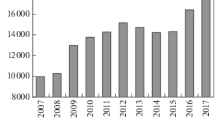Abstract
In the present paper, the effects of inlet pressure on the heat and mass transfer rates of an air cooler are numerically predicted by a local analysis method. The pressures of the moist air vary from 2 to 4 bars. The psychrometric properties such as dew point temperature, relative humidity and humidity ratio are employed to treat the condensing water vapor in the moist air when the surface temperatures are dropped below the dew point. The effects of the inlet pressures on the heat transfer rate, the dew point temperature, the rate of condensed water, the outlet temperature of air and cooling water are calculated. The condensation process of water vapor is discussed in detail. The results of present calculations are compared with the test data and shows good agreements.
Similar content being viewed by others
Abbreviations
- A :
-
Heat transfer area or area (m2)
- C :
-
Dimensional parameter, see Eq. (2)
- C p :
-
Specific heat (kJ/kg°C)
- D h :
-
Hydraulic diameter of tube (m)
- f :
-
Fouling coefficient (m2°C s/kJ)
- H :
-
Length of fin (m)
- h :
-
Heat transfer coefficient (kJ/s/m2)
- h d :
-
Mass Transfer coefficient (kg/s/m2)
- I, K :
-
Bessel function
- i, j :
-
Index
- i fg :
-
Latent heat of vaporization (kJ/kg)
- J (s),J i (s):
-
Modified j-factors
- k :
-
Thermal conductivity (kJ/s/m/°C)
- L ent :
-
Entrance length of tube (m)
- l :
-
Equivalent length of fin (m)
- m, n :
-
Number of elements inx andy directions
- Pr:
-
Prandtl number
- \(\dot q\) :
-
Heat transfer rate (kJ/s)
- r1,r2:
-
Inner and outer radius of circular fin (m)
- Re:
-
Reynolds number
- s :
-
Fin pitch (m)
- T :
-
Hot air temperature
- t :
-
Cold water temperature
- U :
-
Overall heat transfer coefficient (kJ/s/m2/°C)
- V :
-
Mean velocity (m/s)
- W :
-
Humidity ratio (kg/kg) or width of continuous fin (m)
- x :
-
Coordinate
- y :
-
Fin spacing (m) or coordinate
- Δx, Δy :
-
Size of element (m)
- δ:
-
Fin thickness (m)
- δQ :
-
Local heat transfer rate at element (kJ/s)
- \(\delta \dot m\) :
-
Local condensation rate of water vapor (kg/s)
- η:
-
Fin efficiency
- 0, 1:
-
Order of Bessel function
- c :
-
Cold water
- cs :
-
Cross sectional area
- cont :
-
Fin-tube contact
- f :
-
Fin
- f, i :
-
Fin in sector
- h :
-
Hot air
- i, j :
-
Index
- s :
-
Fin spacing or overall surface
- w :
-
Heat transfer surface
References
Gnielinski, V., 1976, “New Equation for Heat and Mass Transfer in Turbulent Pipe and Channel Flow,”Int. Chem. Eng., Vol. 16, pp. 358–369.
Hill, J. M. and Jeter, S. M., 1991, “A Linear Subgrid Cooling and Dehumidification Coil Model with Emphasis on Mass Transfer,”ASHRAE Trans., Vol. 97, Part 2, pp. 118–128.
Hu, X., Zhang, L. and Jacobi, A. M., 1994, “Surface Irregularity Effects of Droplets and Retained Condensate on Local Heat Transfer to Finned Tubes in Cross-Flow,”ASHRAE Trans., Vol. 100, Part 1, pp. 375–381.
Holmann, J. P., 1992,Heat Transfer, Mc-Graw-Hill, New York, pp. 550–561.
Jung, H. H., Shin, H. T., Kim, K. H. and Lee, C. S., 1991, “A Study on Cross Type Heat Exchanger Using Element Method,”J. of Air-Conditioning and Refrig. Engrg., Vol. 3, No. 2, pp. 114–122. (in Korean)
Jung, H. H., 1994, “A Study on Effect of Maldistribution of Frontal Air Velocity on Heat Transfer Rate of Vehicle Radiator,” inTransport Phenomena in Thermal Engineering, ed. Lee, J. S., Chung, S. H. and Kim, K. H., pp. 1237–1242, Begell House, Inc..
Jung, H. H., 1996, “A Study on the Fin Efficiency of Continuous Fin-Tube Heat Exchanger,”J. of Korean Society of Marine Engineers, Vol. 20, No. 5, pp. 76–81 (in Korean)
Jung, H. H. and Hong, S. H., 1997, “Program Development for Predicting Heat and Mass Transfer Rate in Cross-Type Heat Exchanger,”J. of Air-Con. and Refrig., Vol. 5, pp. 153–161.
McQuiston, F. C. and Parker, J. D., 1994,Heating, Ventilating and Air—Conditioning Analysis and Design, 4th ed. John Wiley & Sons, Inc., pp. 604–617.
Author information
Authors and Affiliations
Corresponding author
Rights and permissions
About this article
Cite this article
Jung, H.H. A study on the effects of system pressure on heat and mass transfer rates of an air cooler. KSME International Journal 16, 696–702 (2002). https://doi.org/10.1007/BF03184819
Received:
Revised:
Issue Date:
DOI: https://doi.org/10.1007/BF03184819




